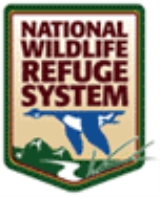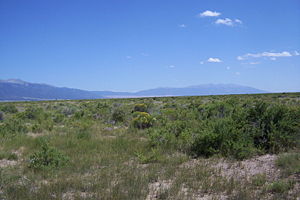
Baca National Wildlife Refuge
Encyclopedia


United States
The United States of America is a federal constitutional republic comprising fifty states and a federal district...
National Wildlife Refuge
National Wildlife Refuge
National Wildlife Refuge is a designation for certain protected areas of the United States managed by the United States Fish and Wildlife Service. The National Wildlife Refuge System is the world's premiere system of public lands and waters set aside to conserve America's fish, wildlife and plants...
located in southern Colorado
Colorado
Colorado is a U.S. state that encompasses much of the Rocky Mountains as well as the northeastern portion of the Colorado Plateau and the western edge of the Great Plains...
. It is located on the lands of the Luis Maria Baca Grant No. 4
Luis Maria Baca Grant No. 4
The Luis Maria Baca Grant No. 4, south of Crestone, Colorado, was a large land grant made in 1860 by the United States to the heirs of the original Vegas Grandes Grant at Las Vegas, New Mexico. Title to the grant at Las Vegas was clouded by a second grant of the same land. The Baca heirs were...
near Crestone, Colorado
Crestone, Colorado
Crestone is a statutory town in Saguache County in Southwestern Colorado, United States. The population was 73 at the 2000 census. It is a small village at the foot of the western slope of the Sangre de Cristo Range, in the northern part of the San Luis Valley. Crestone was a small mining town, but...
in the San Luis Valley
San Luis Valley
The San Luis Valley is an extensive alpine valley in the U.S. states of Colorado and New Mexico covering approximately and sitting at an average elevation of above sea level. The valley sits atop the Rio Grande Rift and is drained to the south by the Rio Grande River, which rises in the San Juan...
in southern Saguache
Saguache County, Colorado
Saguache County is the seventh most extensive of the 64 counties of the state of Colorado of the United States. The county name comes from a Ute language word meaning “blue earth” or “water at blue earth”. The county population was 5,917 at U.S. Census 2000...
and northern Alamosa
Alamosa County, Colorado
Alamosa County is one of the 64 counties of the state of Colorado of the United States. The county name is the Spanish language word for a "grove of cottonwood trees." The county population was 14,966 at U.S. Census 2000...
counties, about 30 miles (48.3 km) northeast of the town of Alamosa
Alamosa, Colorado
The city of Alamosa is a Home Rule Municipality that is the county seat and the most populous city of Alamosa County, Colorado, United States. The United States Census Bureau estimates that the city population was 8,682 in 2005...
, on the west side of the Sangre de Cristo Range
Sangre de Cristo Range
The Sangre de Cristo Range, called the East Range locally in the San Luis Valley, is a narrow mountain range of the Rocky Mountains running north and south along the east side of the Rio Grande Rift in southern Colorado in the United States...
. The site was authorized by the United States Congress
United States Congress
The United States Congress is the bicameral legislature of the federal government of the United States, consisting of the Senate and the House of Representatives. The Congress meets in the United States Capitol in Washington, D.C....
in 2000 as part of legislation that also authorized the nearby Great Sand Dunes National Park. It was formally established in 2003 when administration began under the United States Fish and Wildlife Service
United States Fish and Wildlife Service
The United States Fish and Wildlife Service is a federal government agency within the United States Department of the Interior dedicated to the management of fish, wildlife, and natural habitats...
. It is administered jointly with the nearby Alamosa
Alamosa National Wildlife Refuge
The Alamosa National Wildlife Refuge is an United States National Wildlife Refuge located in southern Colorado. The site is located in the San Luis Valley along the east side of the Rio Grande approximately southeast of Alamosa primarily in southeastern Alamosa County, although very small parts...
and Monte Vista
Monte Vista National Wildlife Refuge
Monte Vista National Wildlife Refuge is a United States National Wildlife Refuge located in southern Colorado. The refuge is located in the San Luis Valley approximately 10 miles west of the town of Alamosa in southeastern Rio Grande and western Alamosa counties, in the watershed of the Rio Grande...
NWR as part of the Alamosa/Baca/Monte Verde Complex.
The refuge consists of rangeland
Rangeland
Rangelands are vast natural landscapes in the form of grasslands, shrublands, woodlands, wetlands, and deserts. Types of rangelands include tallgrass and shortgrass prairies, desert grasslands and shrublands, woodlands, savannas, chaparrals, steppes, and tundras...
and some riparian wetland
Wetland
A wetland is an area of land whose soil is saturated with water either permanently or seasonally. Wetlands are categorised by their characteristic vegetation, which is adapted to these unique soil conditions....
s. It includes several thousand acres of irrigated
Irrigation
Irrigation may be defined as the science of artificial application of water to the land or soil. It is used to assist in the growing of agricultural crops, maintenance of landscapes, and revegetation of disturbed soils in dry areas and during periods of inadequate rainfall...
hay meadows. Several streams arising in the nearby Sangre de Cristos flow onto the Refuge. The lower reaches of Crestone Creek which is a spring-fed perennial stream is inhabited by four native fish species: Rio Grande sucker (Catostomus plebeius), Rio Grande chub (Gila pandora), fathead minnow (Pimephales promelas), and longnose dace (Rhinichthys cataractae)
The original ranch headquarters and other buildings are on the wildlife refuge. As is usual on federal wildlife refuges, grazing and hay production continue on a limited basis. The establishment of the refuge and national park was part of complex arrangement of land transfers undertaken by the federal government in cooperation with the Nature Conservancy
The Nature Conservancy
The Nature Conservancy is a US charitable environmental organization that works to preserve the plants, animals, and natural communities that represent the diversity of life on Earth by protecting the lands and waters they need to survive....
and the State of Colorado
Colorado
Colorado is a U.S. state that encompasses much of the Rocky Mountains as well as the northeastern portion of the Colorado Plateau and the western edge of the Great Plains...
. Approximately 3300 acres (1,335.5 ha) of the land was previously under the management of the U.S. Bureau of Reclamation and was transferred to the Fish and Wildlife Service. Approximately 97036 acres (39,269.1 ha) of the land for the refuge and park was part of the historic Baca Ranch and was purchased by the Nature Conservancy before its transfer to the federal government. The refuge forms part of complex of wetland
Wetland
A wetland is an area of land whose soil is saturated with water either permanently or seasonally. Wetlands are categorised by their characteristic vegetation, which is adapted to these unique soil conditions....
s in the San Luis Valley consists of lands of nearby landowners, including the Colorado Board of Land Commissioners, the National Park Service
National Park Service
The National Park Service is the U.S. federal agency that manages all national parks, many national monuments, and other conservation and historical properties with various title designations...
, and the Nature Conservancy.
Oil and gas exploration
The mineral rights to the lands of the Baca NWR are owned by a third party, Lexam Explorations (U.S.A.) Inc. (Lexam). There is believed to be a small chance that commercial quantities of natural gasNatural gas
Natural gas is a naturally occurring gas mixture consisting primarily of methane, typically with 0–20% higher hydrocarbons . It is found associated with other hydrocarbon fuel, in coal beds, as methane clathrates, and is an important fuel source and a major feedstock for fertilizers.Most natural...
may be discovered (An existing artesian well on the land, called "the gas well", produced enough gas to heat one home) Litigation by the San Luis Valley Ecosystem Council contesting the environmental assessment with respect to the drilling of two exploratory wells resulted in a settlement in September, 2010 requiring preparation of a new assessment by the U.S. Fish and Wildlife Service. Completion of a draft environmental assessment was announced by the Fish and Wildlife Service on January 7, 2011 and was made available for download or viewing at the refuge's website. Proposed executive summary:
Implementation of the Preferred Alternative – the Service is requiring that specific protective measures and standards are followed during all phases of oil and gas exploration being proposed by Lexam, including the intended drilling of two exploratory gas wells on the Refuge, to ensure maximum protection of the surface estate (including all surface and subsurface natural resources not considered minerals) of the Refuge and associated cultural, socioeconomic, and aesthetic resources from unreasonable degradation or impacts. With these requirements incorporated into Lexam’s Plan of Operations, potential impacts are expected to be less than significant in regards to NEPA. Information gathered in this Draft EA indicates that the temporary nature of the proposed exploration (<180 days), along with implementation of the preferred alternative, will not unreasonably degrade or result in significant impacts to the surface estate (including all surface and subsurface natural resources not considered to be minerals) of the Refuge and associated cultural, socioeconomic, and aesthetic resources.
A public meeting was held on Wednesday January 26 at 6:00 p.m. at the Colorado College Baca Campus Conference Center in Crestone, Colorado. It was an informational open house with a presentation by the Fish and Wildlife Service followed by a question-and-answer session. Written comments regarding the environmental assessment were accepted at this meeting.
"There’s no legal way to say ‘no’ for that mineral owner to access those minerals,” [Mike Blenden, Project Leader, San Luis Valley NWR Complex] said
Comments can also be sent via mail to David Lucas, Chief, Division of Refuge Planning, U.S. Fish and Wildlife Service, Division of Refuge Planning, P.O. Box 25484, Denver, CO 80225-0486 or via email to: BacaDraftEAComments at fws.gov and must be received no later than February 7, 2011.
The draft assessment includes consideration of the option of purchasing the mineral rights but rejects the $8.4 million demanded by Lexam as not a fair market price. By the terms of a Federal District Court settlement the final environmental assessment is due April 1, 2011.
External links and further reading
- U.S. Fish and Wildlife Service site for Baca NWR This address redirects to the Fish and Wildlife Service website, click on the map to access the Baca page.ff
- "Drilling Envisioned in Colorado Wildlife Refuge" Morning EditionMorning EditionMorning Edition is an American radio news program produced and distributed by National Public Radio . It airs weekday mornings and runs for two hours, and many stations repeat one or both hours. The show feeds live from 05:00 to 09:00 ET, with feeds and updates as required until noon...
report by Jeff Brady on NPRNPRNPR, formerly National Public Radio, is a privately and publicly funded non-profit membership media organization that serves as a national syndicator to a network of 900 public radio stations in the United States. NPR was created in 1970, following congressional passage of the Public Broadcasting...
, January 10, 2008

